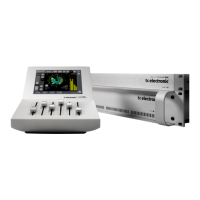119
lM6
basedleveljumpsarecurrentlycreatinghavocindigital
TV, and LM6 helps correct that situation. The LM6
Loudness Meter can be used to control level and improve
sound, not only in Dolby AC3 based transmissions, but
also on other broadcast platforms, such as analog TV,
mobile TV and IPTV.
To summarize: LM6 is part of a holistic and universal
approach to loudness control, starting at the production
or live engineer. When she realizes the dynamic range
at her disposal, less processing is needed at later stages
of a distribution chain. The chain ends with the capability
of quality controlling everything upstream by applying the
same loudness measure for logging purposes: A closed
loop.
Welcome to a new, standardized world of audio leveling.
Across genres, across formats, across the globe.
Display
LM6mayuseeitherthemeasurementunitofLU(Loudness
Units)orLUFS(LoudnessUnitsFullScale).LUandLUFS
are measurements in dB, reflecting the estimated gain
offsettoarriveatacertainReferenceLoudness(LU)or
MaximumLoudness(LUFS)asdefinedinBS.1770.Since
acommonreferencepointforLUhasnotbeenagreedon
atthetimeofwriting,LUFS(or“LKFS”,pointingspecifically
to the Leq(R2LB) weighting of BS.1770), might be favored
initiallytoavoidambiguoususeofthetermLU.
The effectiveness of any loudness meter depends on
both the graphical appearance and dynamic behavior
of its display, as well as on its underlying measurement
algorithms. A short-term loudness meter also relies on
themeasurementalgorithm’sabilitytooutputpertinent
loudness information using different analysis windows,
for instance, 200-800 ms for running realtime updates.
It should be noted how the optimum size of this window
variesfromstudytostudy,possiblybecausetheobjective
ofarunningdisplayhasn’tbeenfullyagreedupon.
Formalevaluationofavisualizationsystemischallenging:
Firstofall,oneormoremetricsmustbedefinedbywhich
the display should be evaluated. The correspondence
between the sound heard and the picture seen is one
aspect to be evaluated. Another metric could characterize
the speed of reading the meter reliably.
InTCElectronicLM2,LM5andLM6,short-term,mid-term
and long-term of loudness measurements are tied together
coherently, and displayed in novel ways (angular reading
and radar) that were preferred in its development and
test phases. However, we remain open to suggestions for
further improvement of the visualization of loudness.
Post Script
Control of loudness is the only audio issue that has made It
to the political agenda. Political regulation is currently being
putintoeffectinEuropetopreventhearingdamageand
disturbances from PA systems, and to avoid annoying level
jumpsduringcommercialbreaksintelevision.InAustralia,
something similar may happen.
Many years of research into loudness of not only
dialog, but also of loudness relating to any type of audio
programming, has brought TC to the forefront of companies
in the world to perform realtime loudness measurement
andcontrol.Therefore,TChastakenactivepartin
loudnessstandardizationeffortsinJapan,theUnited
States,Europeandotherareas.
In broadcast, digitization is driving the number of AV
channels and platforms up, while the total number
of viewers remains roughly the same. On the sound
production side, it is therefore important that delivery
criteria can be easily specified and met, even by people
not primarily concerned with audio: Journalists, musicians,
videoeditors,marketingprofessionalsetc.
Usingonlydialogbasedaudiomeasurementsindigital
broadcast, has led to ambiguous level management, more
leveljumpsbetweenprograms,andextratimespenton
audio production and management in general. Non-dialog

